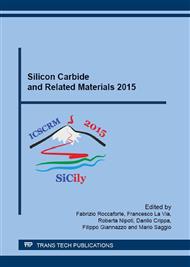[1]
S. Dimitrijev, J. Han, H. Amini Moghadam, A. Aminbeidokhti, Power-switching applications beyond silicon: Status and future prospects of SiC and GaN devices, MRS Bull., 40 (2015) 399-405.
DOI: 10.1557/mrs.2015.89
Google Scholar
[2]
A. L. Lelis, R. Green, D. B. Habersat, M. El, Basic mechanisms of threshold voltage instability and implications for reliability testing of SiC MOSFETS, IEEE Trans. Electron Devices, 62 (2015) 316-322.
DOI: 10.1109/ted.2014.2356172
Google Scholar
[3]
D. Habersat, A. Lelis, Improved observation of SiC/SiO2 oxide charge traps using MOS C–V, Mater. Sci. Forum, 679 (2011) 366-369.
DOI: 10.4028/www.scientific.net/msf.679-680.366
Google Scholar
[4]
J. A. Cooper, Advances in SiC MOS technology, physica status solidi (a), 162 (1997) 305-319.
Google Scholar
[5]
D. Okamoto, H. Yano, Y. Oshiro, T. Hatayama, Y. Uraoka, T. Fuyuki, Investigation of near interface traps generated by NO direct oxidation in C-face 4H-SiC Metal-Oxide-Semiconductor structures, Appl. Phys. Express, 2 (2009) 021201.
DOI: 10.1143/apex.2.021201
Google Scholar
[6]
H. Amini Moghadam, S. Dimitrijev, J. Han, D. Haasmann, A. Aminbeidokhti, Transient-Current method for measurement of active near-interface oxide traps in 4H-SiC MOS capacitors and MOSFETs, IEEE Trans. Electron Devices, 62 (2015) 2670-2674.
DOI: 10.1109/ted.2015.2440444
Google Scholar
[7]
D. Haasmann, S. Dimitrijev, Energy position of the active near-interface traps in metal–oxide–semiconductor field-effect transistors on 4H-SiC, Appl. Phys. Lett. 103 (2013) 113506.
DOI: 10.1063/1.4821362
Google Scholar
[8]
M. Gurfinkel, H. D. Xiong, K. P. Cheung, J. S. Suehle, J. B. Bernstein, Y. Shapira, A. L. Lelis, D. Habersat, N. Goldsman, Charactrization of transient gate oxide trapping in SiC MOSFETs using fast I–V techniques, IEEE Trans. Electron Devices, 55 (2008).
DOI: 10.1109/ted.2008.926626
Google Scholar
[9]
D. Haasmann, S. Dimitrijev, J. Han, A. Iacopi, Growth of gate oxides on 4H-SiC by NO at low partial pressures, Mater. Sci. Forum, 778 (2014) 627-630.
DOI: 10.4028/www.scientific.net/msf.778-780.627
Google Scholar
[10]
F. Pregaldiny, C. Lallement, D. Mathiot, Accounting for quantum mechanical effects from accumulation to inversion, in a fully analytical surface-potential-based MOSFET model, Solid-State Electronics, 48 (2004) 781-787.
DOI: 10.1016/j.sse.2003.12.010
Google Scholar


